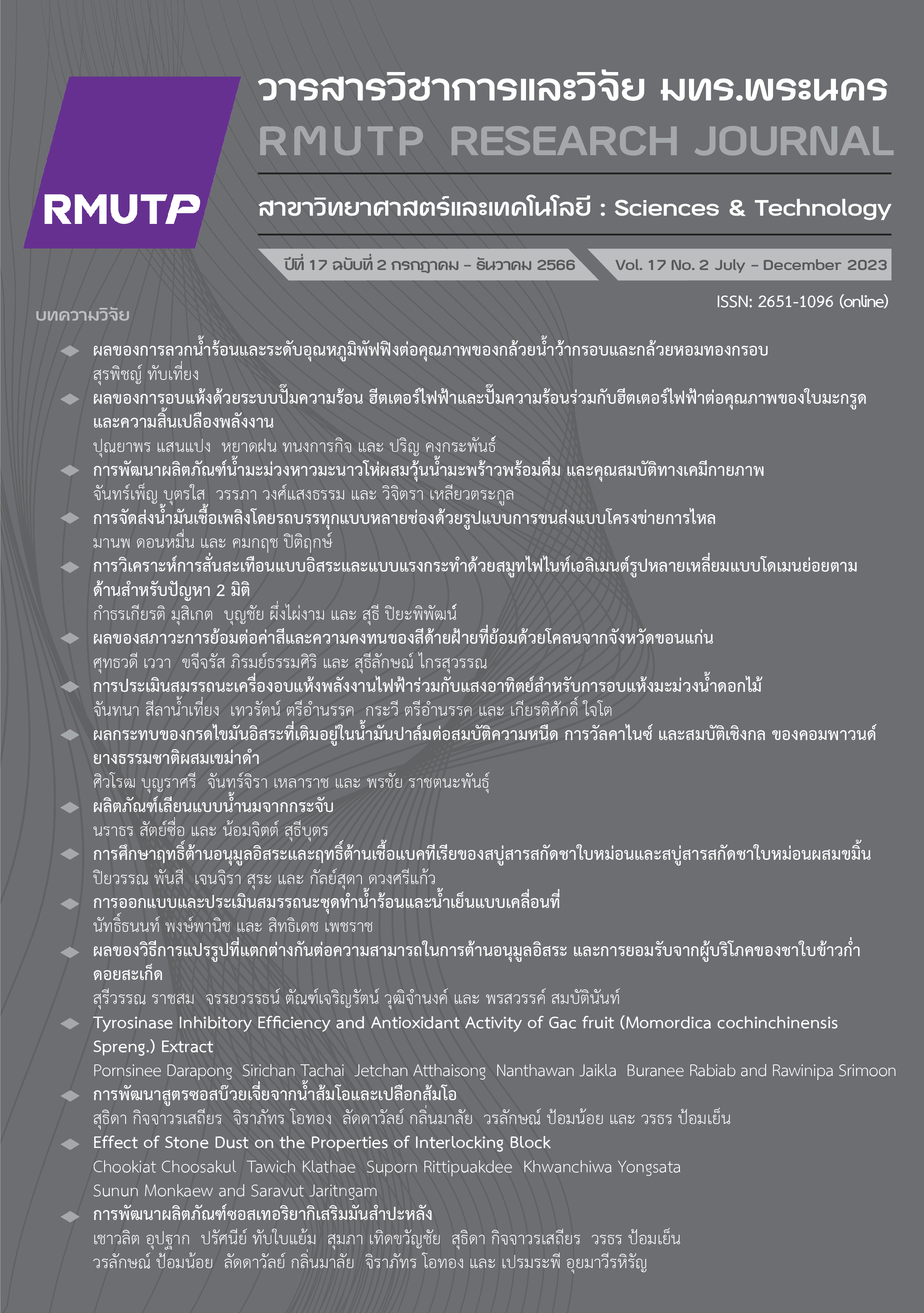Imitation Milk Product from Water Caltrop
Main Article Content
Abstract
The development of imitation milk products from Water Caltrop was aimed to study the recipes and production processes of imitation milk products from Water Caltrop, to study the changing quality during storage, and to study the nutritional value of this product. The study found that the more significant amount of water used to blend with the Water Caltrop reduced the product's protein content and viscousness. The appropriate amount of Water Caltrop per water was 1: 2.5 (weight: weight). The product has a protein content of 3.03%. The imitation milk from Water Caltrop with a higher amount of xanthan gum results in increased viscousness. The suitable amount of xanthan gum was 0.1 % of the total ingredient. As a result, the product is homogeneous, not separate in layers. Imitation milk product from Water Caltrop was pasteurized at a temperature of 64 ° C for 30 min. As a result, the product can be stored for 9 days at 5±1°C, and the total viable count of microorganisms also passes according to the standard of pasteurized milk. Safe to consume. The developed imitation milk product from Water Caltrop provides 29.22 kcal/100g and the protein, fat, and carbohydrate content were 3.37%, 0.22%, and 3.42%, respectively.
Article Details

This work is licensed under a Creative Commons Attribution-NonCommercial-NoDerivatives 4.0 International License.
ลิขสิทธ์ ของมหาวิทยาลัยเทคโนโลยีราชมงคลพระนครReferences
S. Che, “Cow milk protein allergy,” CMPA, The Pharmaceutical Association of Thailand under Royal Patronage. Bangkok: Mahidol University, 2018.
Market Thing, Cow’s milk allergy, Market thing All right, 2020.
T. Kitisripanya, “Dairy from plants and the use of sour milk products,” 1st ed. Bangkok: Mahidol University, 2018.
A. Rinphol, N. Luangsang and P. Donmon, “Product development of cereal drink,” in proceedings of 49th Kasetsart University Annual Conference: Agro-Industry, Kasatsart University: Bangkok, 2011, pp. 141-147.
S. Piti, Body happiness society, 1st Ed. happy book: Thailand. 2014.
Bureau of Nutrition Department of Health Ministry of Public Health. Nutritive Values of Thai food, 3rd ed. Nonthaburi: Ministry of Public Health, 2001.
P. Karpilanondh, S. Ruthathip and U. Chikhantod, “Frying and crisp crackers products from Water Chestnut,” Agricultural Journal, Vol. 49, no. 2 (Suppl), pp. 257-260, 2018.
AOAC, Official Methods of Analysis of AOAC International, 19th edition, Association of Analytical Communities: Maryland, 2012.
O. Omueti and K. Ajmale, “Chemical and sensory attributes of soy-corn milk beverage,” Journal of Biotechnology, Vol. 4, no. 6, pp. 847-851, 2005.
P. Rujirapisit, “Chemical composition and physio chemical properties of Chinese water Chestnut (Eleocharis Dulcis Trin) Flour,” University of the Thai Chamber of Commerce Journal, Vol. 28 no. 1, pp. 168-178, Jan-Mar. 2008.
J. Tirasarat and C. Thanomwong, “Production of healthy beverage from Homnil rice,” KKU Science Journal, Vol. 43, no. 3, pp. 395-402, 2015.
R. Ongsaranakom, “Product development Suaeda maritima ready to drink,” M.S. Thesis, Department of Home Economics, Rajamangala University of Technology Phra Nakhon, Bangkok, Thailand, 2016.
K. Sriroth and K. Piyachomkwan, Flour of technology, 3rd ed. Bangkok: Kasetsart University, 2003.
M. Ongsaranakom, S. Subhimaras and N. Chinrahast, “Production of non-dairy beverage from pressed Macadamia nut,” National Graduate Research Conference, Vol. 12, no. 1, pp. 1534-1544, Feb. 2009.
D. T. Rusch, “Vegetable fat based dairy substitutes,” Food Technology, Vol. 25, 1971, pp. 486-490.
T. Paseephol, N. Injun and S. Sukrk, “Development of sterilized soy milk mixed with mango juice,” MSU Journal, Vol. 13, no. 1, pp. 465-471, 2017.
C. Hongchai and W. Bunchoo. “Effect of stabilizers on the physiochemical properties of soy milk ice cream,” Agricultural Science Journal, Vol. 46, no. 3, (Suppl), pp. 405-408, 2015.
H.D. Graham, Food Hydrocolloids, 1st ed. United Kingdom: AVI Publishing company, Inc, 1997.
E. Dickinson, “Stability and rheological implications of electrostatic milk protein-polysaccharide interaction.” Trend in food science & Technology. no. 9, pp. 347-354, 1998.
A. Nusinovitch, Hydrocolloid application, 1st ed. New York: blackie academic and Professional, 1997.
S. Tanopanuwat, Development of pearl beverage, Thesis, Department of Product Development. Kasatsart University, Bangkok, Thailand, 2005.
THAI Industrial Standards Institute, TISI Standard 738, 2547.
THAI Community Product Standard, TCPS Standard 281, 2015.
R. Surakarnkul, P. Unprasert and C. Charoenroongruang, “Production of nutritious rice milk,” in food Journal, Pathum Thani, 2006, Vol. 36pp. 75-84.


